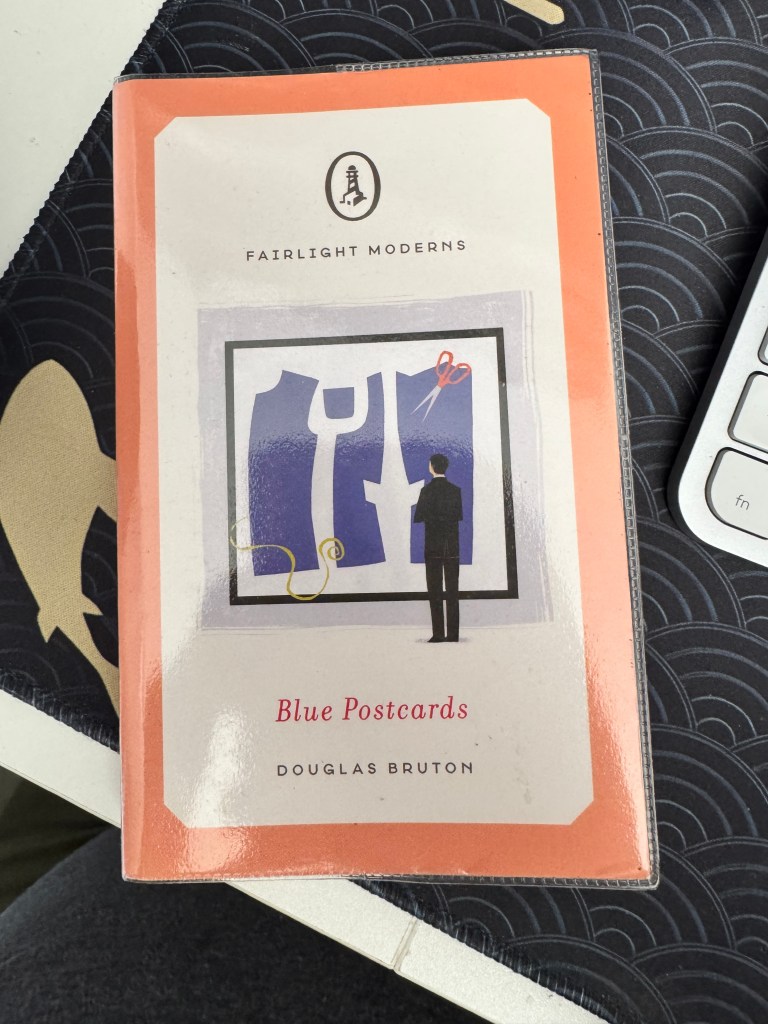
Blue postcards by Douglas Bruton
Scottish fiction
Source – Library book
I’m unsure if it was this book or another from the Fairlight modern series I first saw on BookTube. I was captured by the cover and shape of the books. They have a distinct look across the series and are also great pocket-sized books. But it was one of my favourite Vloggers, Shaun from Shaun Breathes Books. He loved this book, and he went on to talk to the writer about it.I had it down on my list of books to keep an eye out for so when I saw it at my local library before anywhere else, I had to get it to read. I don’t read many non-translated books, but Shaun is someone I trust to highlight a book enough to at least get hold of a copy to have and try. He didn’t disappoint with this. I then read up about Douglas and saw he was from the Scottish Borders, I m not sure where. Still, one of my favourite bookshops is in that area, the excellent Mainstreet Trading company in St Boswells near Melrose is a gem of a bookshop, and the Cafe also has a great deli.
It is not easy to escape the drag and pull of time; its laws are pretty specific. And in the end a life lived is soon forgotten. My father, for example: all that’s left of him now are stories I tell to my children, and telling them over and over they shift, a little each time, so I am not sure how much they are true. And when I say, Now the street has a different name and there is a tailor there,’ what does that ‘now’ signify, for he is not there as I write this but was there once, a long time ago, before I was born even. I was born on 14 May 1957. It is a small coincidence that the date of my birth is the date stamped on the reverse side of the blue postcard and it is not that fact that made me purchase the card
When he brought the card
This book, told in short paragraphs, five hundred in all, captures two people and the connection, one could almost say the thread between them, which would be blue. The first is Henri, the last of a generation of tailors who lived on the French equivalent of London’s Savile Row. A man that every day uses Blue tailors’ chalk in his job but also has always left a blue Thekhelet thread in every one of his suits .so when one day the French conceptial artist Yves Klein heads into his shop for a suit the connection ios made between the two men Klein a man who mainly worked in Blue so much he had a shade of blue named after him. Also, our narrator buys a blue postcard from a girl; he is a collector of all things blue. The story is an ode to blue but also to lost worlds, lost hopes, and memories.
II2. There is a distance that comes between the paint when it is just pigment and how it appears on the canvas when the medium has dried.
It is like something has been lost somewhere between the powdered blue and the finished painting – and not just the blue. This was a trouble to Yves Klein.
II3. Not just with powdered blue, but rose and red and yellow pigments also. Indeed all colours can suffer this loss of intensity. It perhaps explains why artists seek to compensate for that something lost by putting complementary colours next to each other in an effort to replace the loss with a different intensity.
How Yves came up with his famous shade of Blue
This is a book that is unique in a way that it is hard to say what it is other than an ode to Blue and the fans of Blue from the tailor who, every day, uses his blue chalk and his little trademark th Yves Klein I vaguely was aware of but he was a n that lived n[blue as well. Then our narrator is a collector of all things blue. He reads Klein’s postcard in blue, of course, and the three stories are woven like a blue cloth, like a selection of memories faded like that blueish light in the early morning you sometimes get. I loved the book, it is a start book if that makes sense. I love books that go above form. I love books that use art. I love blue as well. I even listened to The Blue Nile, a Scottish band with a melancholy Sound. I think this is a book most people would find something in and love. It is a short read, and it can be read in an evening or a day or two if you get sidetracked by Klein’s art and think about blue along the way, which isn’t such a bad thing. Have you read this book or any others from the Fairlight series? Looking to know where to try next in the series of books?
Related
Published by







